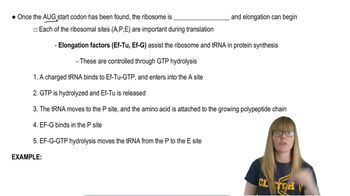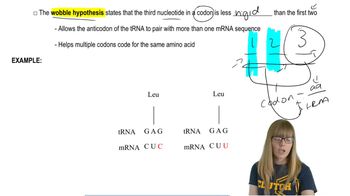Table of contents
- 1. Introduction to Genetics51m
- 2. Mendel's Laws of Inheritance3h 37m
- 3. Extensions to Mendelian Inheritance2h 41m
- 4. Genetic Mapping and Linkage2h 28m
- 5. Genetics of Bacteria and Viruses1h 21m
- 6. Chromosomal Variation1h 48m
- 7. DNA and Chromosome Structure56m
- 8. DNA Replication1h 10m
- 9. Mitosis and Meiosis1h 34m
- 10. Transcription1h 0m
- 11. Translation58m
- 12. Gene Regulation in Prokaryotes1h 19m
- 13. Gene Regulation in Eukaryotes44m
- 14. Genetic Control of Development44m
- 15. Genomes and Genomics1h 50m
- 16. Transposable Elements47m
- 17. Mutation, Repair, and Recombination1h 6m
- 18. Molecular Genetic Tools19m
- 19. Cancer Genetics29m
- 20. Quantitative Genetics1h 26m
- 21. Population Genetics50m
- 22. Evolutionary Genetics29m
11. Translation
Translation
Problem 39b
Textbook Question
Answer the following questions about the accompanying diagram.

What process(es) are illustrated in the diagram?
 Verified step by step guidance
Verified step by step guidance1
Identify the components in the diagram: A represents DNA, B is RNA polymerase, C is mRNA, D is a ribosome, E is the start codon, F is a polypeptide chain, and G is tRNA.
Recognize the processes: The diagram illustrates transcription and translation.
Transcription: RNA polymerase (B) moves along the DNA (A) to synthesize mRNA (C).
Translation: Ribosomes (D) bind to mRNA (C) and use tRNA (G) to assemble amino acids into a polypeptide chain (F).
Note the direction of processes: Transcription occurs in the 5' to 3' direction, and translation begins at the start codon (E) on the mRNA.
Recommended similar problem, with video answer:
 Verified Solution
Verified SolutionThis video solution was recommended by our tutors as helpful for the problem above
Video duration:
2mPlay a video:
Was this helpful?
Key Concepts
Here are the essential concepts you must grasp in order to answer the question correctly.
Translation
Translation is the process by which ribosomes synthesize proteins using messenger RNA (mRNA) as a template. During translation, the ribosome reads the sequence of codons in the mRNA, and transfer RNA (tRNA) molecules bring the corresponding amino acids to form a polypeptide chain. This process is essential for gene expression and the production of proteins that perform various functions in the cell.
Recommended video:
Guided course

Translation initiation
mRNA
Messenger RNA (mRNA) is a type of RNA that carries genetic information from DNA to the ribosome, where proteins are synthesized. It is transcribed from the DNA template during the process of transcription and contains codons that specify the sequence of amino acids in a protein. The structure of mRNA includes a 5' cap and a poly-A tail, which help stabilize the molecule and facilitate its translation.
Recommended video:
Guided course

mRNA Processing
Ribosome
Ribosomes are complex molecular machines found within all living cells that facilitate the translation of mRNA into proteins. They consist of ribosomal RNA (rRNA) and proteins, forming two subunits that come together during protein synthesis. Ribosomes have binding sites for mRNA and tRNA, allowing them to decode the mRNA sequence and link amino acids in the correct order to form a polypeptide chain.
Recommended video:
Guided course

Ribosome Structure

 7:58m
7:58mWatch next
Master Translation initiation with a bite sized video explanation from Kylia Goodner
Start learning



